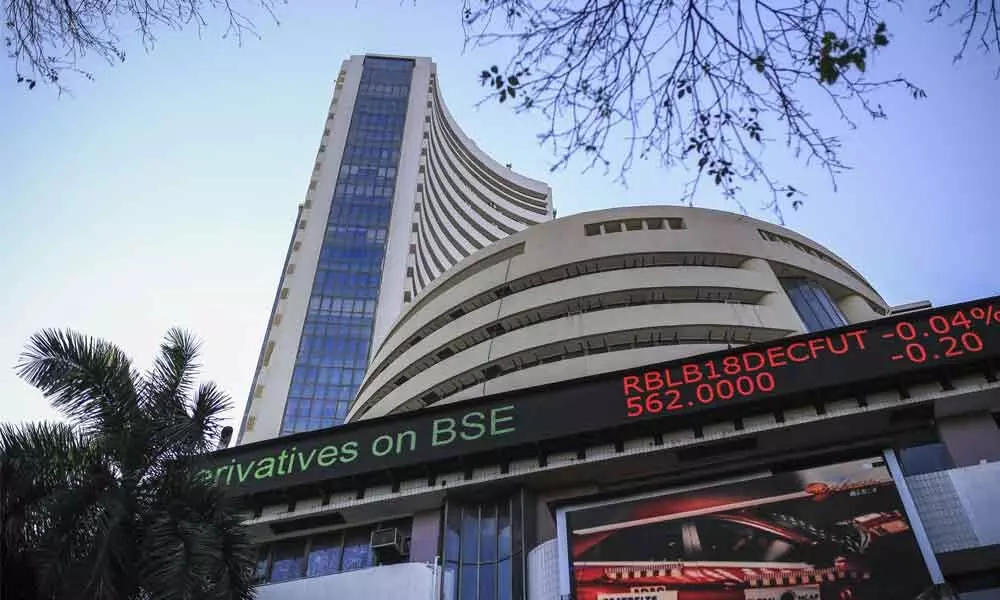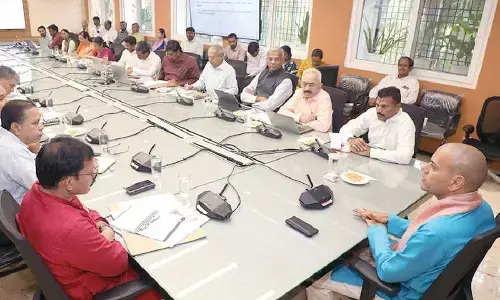FIIs turn net buyers: Has market bottomed out?

Supported by falling international crude oil prices, hopes on ongoing peace talks between Ukraine and Russia war, no negative surprise from the US Federal Reserve
Supported by falling international crude oil prices, hopes on ongoing peace talks between Ukraine and Russia war, no negative surprise from the US Federal Reserve, which announced an expected 25 basis point rate hike, and renewed buying from foreign institutional investors (FIIs); the domestic stock markets logged their biggest gains for a week since February 2021.
The BSE Sensex rallied 2,314 points to 57,864 and the NSE Nifty jumped 657 points to 17,287 during the week, taking total recovery of gains to 10 percent from recent lows. However, the broader markets underperformed benchmark indices.
While the benchmark indices jumped four percent, the BSE Midcap and Smallcap indices gained two percent each. Both Sensex and Nifty are now above their 200-day simple moving averages as they clocked their best week since Feb 2021. The change in FII mood is also one of
key reasons for recovery in equity markets. FIIs were net buyers for two successive sessions after consistent selling in the past one month. Reports suggest that Vanguard Emerging Markets Stock Index Fund acquired stake in total 19 companies by pouring in Rs2,277.2 crore in last few days. With last week's gains, the benchmarks have fully recovered from the losses that followed Russia's invasion of Ukraine.
Market strategists believe India is better placed to combat the external storm because it is in a better position compared to other emerging markets and has significant foreign exchange reserves. China, the world's second largest economy, suddenly came into focus especially after fast rising Covid cases resulted in lockdowns in several cities which fuelled fear that economic activity may be impacted. Concerns about China may prevail unless there is improvement in virus situation.
The Union Finance Ministry is expected to soon seek Cabinet approval for amendments to the Banking Regulation Act, 1949, and possibly other legislation as it kick-starts the process to privatise two state-run lenders. Reports suggest that these are Central Bank of India and Indian Overseas Bank (IOB). It is strongly suggested that from now on, upside moves should not be chased, instead, they should be used to take some money off the table and protect profits. There are also strong possibilities that the traditionally defensive pockets like FMCG, consumption, pharma, and IT will do better.
Listening Post: For years, investors have only had to deal with one overarching market narrative at a time: Covid, then reflation, then supply-chain inflation, then a tardy US Fed, then war. Now, things are getting more complicated. The trouble is that lots of stories suddenly apply at once.
The market's focus on Russia's invasion of Ukraine is being interrupted by the supply-chain effects of Covid lockdowns in Chinese technology hub Shenzhen, imminent tightening by the US Federal Reserve as it tries to catch up with inflation, and the risk to the reflation story as consumer sentiment is crushed by rising prices. The result is a confused, and confusing, market,
exemplified by last fortnight's moves. One day, (exaggerated) hopes of peace in Ukraine led to a standard risk-on start to the day. Oil prices plunged, gold fell and share prices and Treasury yields rose. By the time exchanges closed, the focus had shifted, and not just because peace hopes had been dashed. What was good for stocks one day was mixed the next.
Markets have trouble focusing on more than one thing at a time, partly because multiple stories mess with the cross-market correlations that investors who trade across stocks, bonds, commodities and other assets rely on. Traders who grew up with the post-2008 markets had to make just one decision, whether it was a risk-on or risk-off day.
The prices of almost everything were closely linked to that single factor. War or peace is similarly binary, as Russian sanctions push up oil and other important commodity prices, with all-encompassing, but easy-to-understand macroeconomic effects. Still, narrative uncertainty rarely lasts. As risks get priced in, investors herd together, and a single story comes to dominate. Coming to Indian markets, savvy market observers feel that "The Real game will begin when FIIs turn into buyers and DIIs instead of turning into jobbers (as in the past), will continue to be buyers."
After FIIs ending as net buyers at Indian stock markets in last two sessions, markets are buzzing with speculations whether market has bottomed out and foreign investors may start their shopping again.
F&O / sector watch
Taking cue from cash markets, derivatives segment witnessed robust volumes. On the back of short covering, barring IT, all sectoral indices ended in the green with auto, financials and realty surging the most. From the option data, it can be inferred that maximum Call Open Interest (OI) was seen at 17,300 strike followed by 17,500, 17,400 and 17,600 strikes. Maximum Put Open Interest was seen at 17,200 strike followed by 16,500, 17,000 and 16,700 strikes. Short covering was observed by Call writers at 17000 strike, which pushed the NSE Nifty towards 17,250 mark.
With significant short Open Interest still placed in several stocks, any declines seem to be limited and should provide support to the markets in case of any intermediate dip. Implied Volatility (IV) of Calls closed at 22.73 per cent, while that for Put options closed at 24.17. The Nifty VIX for the week closed at 24.12 per cent, which was higher than the previous week. PCR of OI for the week closed at 1.46.
On higher side, for present 17600-17800 zone will act as a strong resistance zone for Nifty while 17000-16900 zone will provide support on any pull back. Overall, while staying highly cautious at higher levels, profits should be vigilantly protected while keeping leveraged exposures at modest levels. OMC's IOC, BPCL, HPCL and others are contracting crude oil at steep discount to global prices from Russia.
Refiners such as BPCL, Indian Oil and Reliance have deferred planned maintenance shutdowns at some of their units to benefit from prevailing refinery margins. Though they are incurring losses of ₹18 and ₹24 on marketing each litre of petrol and diesel respectively; losses will rapidly shrink as oil has plunged to $100 per barrel from $139 last week. Buy for short term gains. Stock futures looking good are ABFRL, Cholamandalam Fin, Chambal Fertilisers, HAL, Motherson Sumi, Titan and UBL. Stock futures looking weak are Birla Soft, ICICIGI, NALCO, Gujarat Gas, GSPL and Muthoot Finance.
(The author is a stock market expert. He is former vice chairman of AP Planning Board)
STOCK PICKS
Shree Pushkar Chemicals &Fertilisers Limited is engaged in the business of manufacturing and trading of chemicals, dyes and dyes intermediate, cattle feeds, fertilizers and soil conditioner. Started manufacturing Dye Intermediates in 2001 and dyes in 2016, the company not only expanded its portfolio in a horizontal manner, but also in the vertical space which helps it to be least dependent on outside suppliers. Established own captive power plant that reduces electricity cost and makes the company unaffected to power cuts.
The company is a Unique Zero Waste Company with each waste treated to the best possible level and then used to make other value-added products such as Fertilizers and Animal Health & Nutrition Products. One of the leading manufacturer of reactive dyes primarily used for dyeing textiles, for cellulosic fibers like cotton / flex & wool. Reactive dyes uses less water &energy and decreases the processing skills in comparison to conventional dyes industry.
Wide portfolio under one roof like H-Acid, VS, K Acid, Gamma Acid, R Salt, among others. Among the Top-5 manufacturer of SSP in India. PUSHKAR™ Sulphate of Potash (SOP) is a product that provides Potash and Sulphur as nutrients. One of the major benefits of SOP as a fertilizer is that it is completely water soluble and can be easily administered to plants through soil or foliar spray. A zero debt company with in-house funding of ongoing capex plans. Buy on declines for target price of Rs 500 in medium term.
JK Paper Limited is producer of papers and paper boards. The company offers various products office documentation papers, uncoated paper & board, coated paper &board, and packaging board. It offers a range of office documentation papers from economy to premium grades. The
product includes photocopy and multi-purpose papers for use in desktop, inkjet and laser printers, fax machines, photocopiers and multi-functional devices. It offers a range of such uncoated writing &printing paper for varied needs, including the super bright JK Maplitho. Its Uncoated Paper & Board products include JK Bond, JK MICR Cheque Paper, JK Parchment
Paper, JK SS Pulpboard, JK ELEKTRA, JK FINESSE, JK LUMINA and JK SHB. Its Coated Paper & Board products include JK Cote (Matt/ Gloss), JK Superkote / JK Cote Premium (Gloss) and JK Cote Chromo (Matt/Gloss).
Its Packaging Board products include JK Ultima, JK TuffCote, JK TuffPac, JK Endura, JK IV Board, JK Club Card, JK FBL, JK FBU and other. The Company intends to ramp up manufacturing capacity at the expanded unit and generate accruals with the objective to moderate its net debt-EBITDA ratio from 2.52 to less than 1.0 in next 3 years. Accumulate from current levels for medium term target of Rs500.















